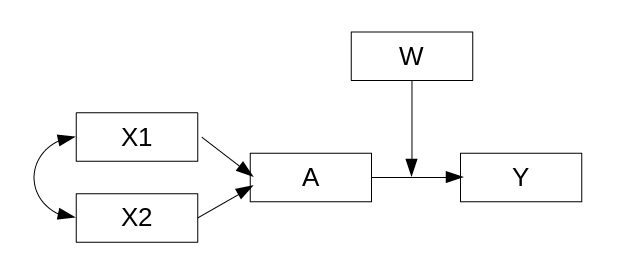OpenMx Structural Equation Modeling
 rranne2@uic.edu
Joined: 12/10/2018
rranne2@uic.edu
Joined: 12/10/2018
latent difference score issues
Hello,
- Read more about latent difference score issues
- 3 comments
- Log in or register to post comments
 blazej
Joined: 11/20/2018
blazej
Joined: 11/20/2018
Looking for help with including a moderator to a path model
Greetings,
this is my 1st post, so please forgive me if this is offtopic.
In sort of new to SEM / modelling in general. So far I managed to make some sense of lavaan() syntax in R, to run a path model like this (file attached).

Before introducing the W moderator (continuous) this model was specified (in lavaan) as:
model <- '
X1 ~~ X2
A ~ X1 + X2
Y ~ A'
All variables are observed and continuous.
 Julia
Joined: 03/29/2012
Julia
Joined: 03/29/2012
Parameter contraints across subgroups
Hi all,
- Read more about Parameter contraints across subgroups
- 3 comments
- Log in or register to post comments
 paulT
Joined: 11/03/2017
paulT
Joined: 11/03/2017
Empirical Underidentification with a bifactor type model
First post by new user: Can anyone give some advice on an empirical under-identification issue please? I am trying to fit the following model:
resVars <- mxPath( from=mylabels, arrows=2,
free=TRUE, values=rep(1,12),
labelatVars <- mxPath( from=c("X1","X2"), arrows=2, connect="unique.pairs",
free=c(TRUE,FALSE,TRUE), values=c(1,0,1), labels=c("varX1","cov","varX2") )
 cjcook
Joined: 05/22/2017
cjcook
Joined: 05/22/2017
LISREL Simulation
Hello,
I am trying to simulate data using the endogenous variables only LISREL model as seen on page 133 of the OpenMx.pdf help documentation. I was able to simulate data from a state space model using the example in the help documentation on page 174. Now I am modifying that piece of code for a LISREL model. However I am running into an error. Below is my code.
- Read more about LISREL Simulation
- 4 comments
- Log in or register to post comments
 Soyoung
Joined: 05/08/2017
Soyoung
Joined: 05/08/2017
multilevel path/structural equation models in OpenMx
Hi,
Is it possible to estimate multilevel path/structural equation models with OpenMx?
If it is possible, is there an example code for multilevel mediation (path) model?
Attached files are the example of multilevel path model using Mplus.
Source: Heck, R. H., & Thomas, S. L. (2015). An introduction to multilevel modeling techniques: MLM and SEM approaches using Mplus. Routledge.
Hope I can do the same analysis using OpenMx.
Thank you in advance.
Soyoung.
 iloo
Joined: 05/26/2010
iloo
Joined: 05/26/2010
Optimization issues - binary with low prevalence
Hey,
I work with OpenMx using a bit different data than most others; often data comes from a full population and has quite many rows (up to 3 million). A common type of analysis is for relatives with one or more binary variables, e.g. observed disease diagnosis, where the prevalence is low, e.g. 1% to 0.05%. The complexity of the models vary from simple 2x2 covariance matrices without any definition variables to 8x8 covariance matrices with several definition variables adjusting the means/thresholds.
 IvanVoronin
Joined: 08/18/2013
IvanVoronin
Joined: 08/18/2013
Wierd estimate of mean in a simple model
Dear all,
I've met a weird issue with means running a simple model.
The data:
Cov<-matrix(
c(10,3.0,6.5,
3.0,10,6.5,
6.5,6.5,10),ncol=3,nrow=3)
library('mvtnorm')
data<-as.data.frame(rmvnorm(1000,mean=rep(100,3),sigma=Cov))
names(data)<-c('X','Y','Z')
The covariance matrix corresponds the model:
X -> Z = 0.5
Y -> Z = 0.5
X <-> Y = 3
X <-> X = 10
Y <-> Y = 10
Z <-> Z = 3.5
All means are 100
The model:
aModel<-mxModel(type='RAM',name='Phenotypic model',
manifestVars=c('X','Y','Z'),
mxPath(from=c('X','Y'),to='Z',connect='single',
- Read more about Wierd estimate of mean in a simple model
- 1 comment
- Log in or register to post comments
 rabil
Joined: 01/14/2010
rabil
Joined: 01/14/2010
Interpreting Output from mxTryHardOrdinal
The output below says a solution was found, but was it?
Begin fit attempt 21 of at maximum 21 tries
- Read more about Interpreting Output from mxTryHardOrdinal
- 2 comments
- Log in or register to post comments
 rabil
Joined: 01/14/2010
rabil
Joined: 01/14/2010
Constrain Total Variance instead of Residual Variance in Ordinal Threshold Path Mdel
The path specification for an ordinal model in the documentation constrains the residual variances for the ordinal variables to 1. I would like to instead constrain the total variance for the ordinal variables to 1. But I'm not sure how to accomplish this. When the total variance is constrained to 1, there residual variance is constrained to 1 minus the factor loading squared (the factor loadings are constrained to be between -1 and 1) as I understand it.
Pagination
- Previous page
- Page 4
- Next page